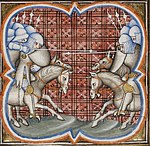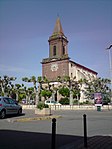Muret

Muret (French pronunciation: [myʁɛ] (listen); in Gascon Occitan Murèth) is a commune in the Haute-Garonne department, of which it is a subprefecture, in the Occitanie region of southwestern France. Its inhabitants are called Muretains. It is an outer suburb of the city of Toulouse, even though it does not belong to Toulouse Métropole, which it has declined to join. It lies southwest of Toulouse and is the largest component of the intercommunality of Le Muretain Agglo. Muret is generally known for the Battle of Muret (1213) and as the birthplace of Clément Ader (1841-1925), inventor and aviation pioneer. It is also the birthplace of the Niel family from which Adolphe Niel, Marshal of France and Minister of War, was derived.
Excerpt from the Wikipedia article Muret (License: CC BY-SA 3.0, Authors, Images).Muret
Rue Clément Ader, Muret
Geographical coordinates (GPS) Address Nearby Places Show on map
Geographical coordinates (GPS)
| Latitude | Longitude |
|---|---|
| N 43.4611 ° | E 1.3267 ° |
Address
Les tapas s'emballent
Rue Clément Ader
31600 Muret
Occitania, France
Open on Google Maps








